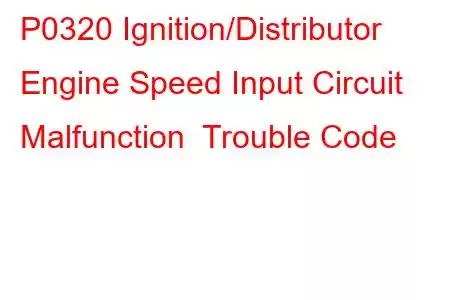P0320 Ignition/Distributor Engine Speed Input Circuit
OBD-II Trouble Code Technical Description
Ignition/Distributor Engine Speed Input Circuit
What does that mean?
This generic powertrain/engine diagnostic trouble code typically applies to all spark ignition engines, including but not limited to certain Ford, Kia, Mazda, and Mercedes vehicles.
The Crankshaft Position Sensor (CKP) provides crankshaft position or crankshaft timing to the Powertrain Control Module or PCM. This information is typically used for engine rpm. The camshaft position sensor (CMP) provides the PCM with the exact location of the camshaft, camshaft timing or distributor timing.
Anytime there is an electrical problem with either of these two circuits, depending on how the manufacturer wants to identify the fault, the PCM will set code P0320. This code is considered to be an electrical circuit fault only.
Troubleshooting steps may vary depending upon manufacturer, type of ignition/distributor/engine speed sensor, and wire colors to the sensor.
Symptoms
Symptoms of a P0320 engine code may include:
Malfunction Indicator Light On Engine cranks but will not start Misfire, Hesitation, Stumble, Lack of PowerCauses
Potential causes for this code to set are:
Open in the control circuit (ground circuit) between the ignition/distributor/engine speed sensor and the PCM Open in the power supply circuit between the ignition/distributor/engine speed sensor and the PCM Short to ground in the power supply circuit to the ignition/distributor/engine speed sensor Ignition/distributor/engine speed sensor faulty Possibly a PCM has failed (highly unlikely)Diagnostic and Repair Procedures
A good starting point is always to check for technical service bulletins (TSB) for your particular vehicle. Your issue may be a known issue with a known fix put out by the manufacturer and can save you time and money during diagnosis.
Next, locate the ignition/distributor/engine speed sensor on your particular vehicle. This may be a crank sensor/cam sensor; it might be a pick up coil/sensor inside the distributor; it may even be a wire coming from the coil going to the PCM to verify ignition system firing. Once located, visually inspect the connectors and wiring. Look for scraping, rubbing, bare wires, burn spots or melted plastic. Pull the connectors apart and carefully inspect the terminals (the metal parts) inside the connectors. See if they look burned or have a green tint indicating corrosion. Use electrical contact cleaner and a plastic bristle brush if cleaning of the terminals is needed. Let dry and apply electrical grease where the terminals contact.
Depending upon the vehicle, the most likely cause for the P0320 to set is poor connections/updated ignition parts. This is why a TSB search on your vehicle cannot be stressed enough.
If you have a scan tool, clear the diagnostic trouble codes from memory, and see if P0320 returns. If it does not, then the connections were most likely your problem.
If the P0320 code does return, we will need to test the sensor and its associated circuits. The next steps will be determined by which type of sensor you have: Hall Effect or Magnetic Pick up. You can usually tell which one you have by the number of wires coming from the sensor. If there are 3 wires from the sensor, it is a Hall Effect sensor. If it has 2 wires, it will be a Magnetic Pick up style sensor.
If it is a Hall Effect sensor, disconnect the harness going to the Camshaft and the Crankshaft Position Sensors. With a Digital Volt Ohm Meter (DVOM), test the 5V power supply circuit going to each sensor to insure it is being powered up (Red lead to the 5V power supply circuit, black lead to a good ground). If there is no 5 volts to the sensor, repair the wiring from the PCM to the sensor, or possible a bad PCM.
If thatâ€
Read: 47


